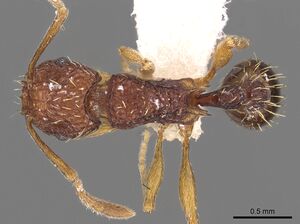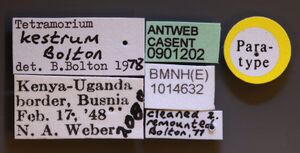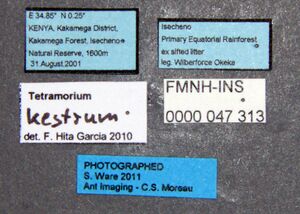Tetramorium kestrum
| Tetramorium kestrum | |
|---|---|

| |
| Scientific classification | |
| Kingdom: | Animalia |
| Phylum: | Arthropoda |
| Class: | Insecta |
| Order: | Hymenoptera |
| Family: | Formicidae |
| Subfamily: | Myrmicinae |
| Tribe: | Crematogastrini |
| Genus: | Tetramorium |
| Species: | T. kestrum |
| Binomial name | |
| Tetramorium kestrum Bolton, 1980 | |
A ground-dwelling, rainforest ant.
Identification
Bolton (1980) - This species is closely related to Tetramorium ataxium and is best separated from it by colour, which in T. kestrum ranges from yellowish brown to orange-brown whilst T. ataxium is dark brown to blackish brown. To this may be added the fact that the ground-sculpture of T. kestrum is obsolete and the scapes tend to be somewhat longer, with SI 100-106 whilst in T. ataxium only a few specimens have SI 100 or slightly more, most having SI 95-99. The two species obviously form a sibling pair and both have a wide distribution, T. ataxium throughout the wet forest zone of West Africa and T. kestrum in the eastern and more southern forested parts of the continent. Their respective ranges do not appear to overlap and it is assumed that they are mutually exclusive.
Keys including this Species
Distribution
Latitudinal Distribution Pattern
Latitudinal Range: 0.25° to -0.317°.
| North Temperate |
North Subtropical |
Tropical | South Subtropical |
South Temperate |
- Source: AntMaps
Distribution based on Regional Taxon Lists
Afrotropical Region: Angola, Democratic Republic of Congo, Kenya, Sudan, Uganda (type locality).
Distribution based on AntMaps
Distribution based on AntWeb specimens
Check data from AntWeb
Countries Occupied
| Number of countries occupied by this species based on AntWiki Regional Taxon Lists. In general, fewer countries occupied indicates a narrower range, while more countries indicates a more widespread species. |

|
Estimated Abundance
| Relative abundance based on number of AntMaps records per species (this species within the purple bar). Fewer records (to the left) indicates a less abundant/encountered species while more records (to the right) indicates more abundant/encountered species. |

|
Biology
Castes
Worker
Images from AntWeb
   
| |
| Paratype of Tetramorium kestrum. Worker. Specimen code casent0901202. Photographer Ryan Perry, uploaded by California Academy of Sciences. | Owned by NHMUK, London, UK. |
   
| |
| Worker. Specimen code fmnhins0000047313. Photographer Stephanie Ware, uploaded by Field Museum. | Owned by FMNH. |
Nomenclature
The following information is derived from Barry Bolton's Online Catalogue of the Ants of the World.
- kestrum. Tetramorium kestrum Bolton, 1980: 300 (w.) UGANDA.
Unless otherwise noted the text for the remainder of this section is reported from the publication that includes the original description.
Description
Worker
Holotype: TL 3.1, HL 0.74, HW 0.66, CI 89, SL 0.68, SI 103, PW 0.47, AL 0.90. Paratypes (8 measured): TL 3.0-3.1, HL 0.74-0.76, HW 0.64-0.66, CI 84-89, SL 0.64-0.68, SI 100-106, PW 0.47-0.48, AL 0.90-0.92. Maximum diameter of eye 0.14, about 0.21-0.22 x HW.
Mandibles longitudinally striate. Anterior clypeal margin entire, without a median notch or impression. Median clypeal carina strong, the remaining clypeal sculpture converging upon it. Frontal carinae strongly developed, reaching back almost to the occipital margin before merging with the cephalic sculpture. Antennal scapes long, SI 100 or more (103 in holotype; range 100-106). Maximum diameter of eye 0.14, about 0.21 x HW. Propodeal spines long and strong, feebly sinuate along their length. Metapleural lobes triangular and acute. Petiole node in profile rectangular, the length of the dorsum slightly greater than the height of the tergal portion of the node. In dorsal view petiole node slightly longer than broad. Dorsum of head to level of posterior margins of eyes with a few strong, widely spaced longitudinal rugae; behind this level and also on the sides above the eyes with a distinct rugoreticulum. Dorsal surfaces of alitrunk, petiole and postpetiole reticulate-rugose, the last more weakly so than the precéding areas. Ground-sculpture between the reticulations minimal on the head and alitrunk so that the surfaces are glossy, but the pedicel segments with some feeble punctulation. First gastral tergite unsculptured. All dorsal surfaces of head and body with numerous standing hairs which are long, stout and blunted apically. Dorsal surfaces of hind tibiae only with minute appressed pubescence. Colour bright orange-brown, the legs yellow.
Type Material
Holotype worker, Uganda (‘Kenya-Uganda border’ on data label): Busnia, 17.11.1948, no. 2080 (N. A. Weber) (Museum of Comparative Zoology). Paratypes. 5 workers with same data as holotype; 3 workers with same data but the number 2080 omitted (MCZ; The Natural History Museum; Naturhistorisches Museum, Basel).
References
References based on Global Ant Biodiversity Informatics
- Bolton B. 1980. The ant tribe Tetramoriini (Hymenoptera: Formicidae). The genus Tetramorium Mayr in the Ethiopian zoogeographical region. Bulletin of the British Museum (Natural History). Entomology 40: 193-384.

